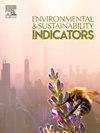Sustainable performance measurement in brick kilns: Proposal of an index with objective and subjective data
IF 5.4
Q1 ENVIRONMENTAL SCIENCES
引用次数: 0
Abstract
This research aims to construct a sustainable performance index for small brick businesses using both objective (emissions measurement) and subjective data (opinions and perceptions of business performance) throughout the brick manufacturing process. The proposed sustainable performance index, which includes both subjective and objective data, generates a more comprehensive index by integrating diverse types of data. To collect information, a structured questionnaire was developed and applied face-to-face to 142 brick-making business owners located in five metropolitan municipalities of Oaxaca (ZMO), Mexico. The measurement of polluting emissions was carried out on-site using Temptop 2000 and Testo 340 equipment. An exploratory factor analysis was conducted with the collected data and the reliability and validity of the scales were tested. The results present a sustainable performance index that integrates the economic dimension, covering commercial and financial phases; the environmental dimension, subdivided into process emissions and production inputs, and the social performance dimension. The component that scored lowest was production inputs, while the component that scored highest was financial performance. The municipality with the worst ranking position is Santa Cruz Amilpas, and the best-positioned municipality is San Andrés Huayapam. These results are significant for the government, producers, and authorities as they provide a basis for defining strategies aimed at sustainable brick production. This includes incorporating technology to enhance economic returns, mitigating negative environmental and human health impacts, and ensuring appropriate social development for employees.
砖窑的可持续绩效衡量:利用主客观数据编制指数的建议
本文章由计算机程序翻译,如有差异,请以英文原文为准。
求助全文
约1分钟内获得全文
求助全文
来源期刊

Environmental and Sustainability Indicators
Environmental Science-Environmental Science (miscellaneous)
CiteScore
7.80
自引率
2.30%
发文量
49
审稿时长
57 days
 求助内容:
求助内容: 应助结果提醒方式:
应助结果提醒方式:


